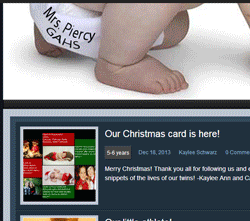Summary
This blogging project facilitates students in an authentic task, experiencing early childhood development learning as they journal their “child’s” growth from birth to 6 years old, using a social media-like platform. Student “couples,” paired using the Myers Briggs personality test, collaborate to take ownership in learning childhood development by conceiving a virtual baby whom they raise over the fundamental early years of development . Student pairs spawn an imaginary child (some groups had twins!), research and apply established biosocial, cognitive, and psychosocial development in concise and captivating blog posts that mirror Instagram or Facebook. In addition to posting about their child, each student is responsible for displaying their understanding by making comments on other student’s blog posts. Posting and commenting allows students to apply what they have learned about biosocial, cognitive, and psychosocial development in an interactive context that reflects modern, real-world social interactions via social media. The students select several different children examples and share the projects with a expert in the field of Child Development (expert)
TIPC Ratings
Ideal – Starting with modeling strategies, the teacher transitions to a facilitator role as student’s research using provided and self-discovered resources towards the authentic task of recording developmentally accurate posts about their conceived child. Each post and comment requires student pairs to synthesize information into a concise social media type post. The blog acts as a tool the students display and interact with their learning. Throughout the project the teacher formatively assesses the students research referring to the Project Rubric.
Target – The teacher initially models the tool (Google Documents and Word Press blog) and methods of communication (posts and comments) for the students, before moving to a facilitation role as students collaborate on posts and communicate via comments. Student reflect on their roles as collaborators in a mid project Google Form, and the teacher formatively assess their level of communication using the Project Rubric, at the end of the project. The students share selected projects with outside experts (Child Psychologists form VCU).
Ideal – Students act to extend their understanding of a child’s development in the genuine format of social media posts and comments. The project requires critical thinking in applying established norms of child development to the content of one’s own child. The teacher promotes the authentic task of regular social media posts about one’s own life and formatively assesses students problem solving the Project Rubric, at the end of the project.
Target – Students spawn an imaginary child using research and original ideas that provides them with a unique experience in learning. The teacher acts as a facilitator towards for the student socially relevant, real-world task, of creating an online presence. Students work beyond one post with one image per age-range, as most couples proudly post multiple times and include personal image galleries and videos. The teacher uses the Project Rubric to formatively assess the students level of creativity and innovation throughout the project.
Download Files
Baby Blogging Lesson Folder

Contents:
- Lesson Plan
- Rubric
- Student Artifacts
- The Baby Blog (the blog)
- More Baby Blog(the blog)




